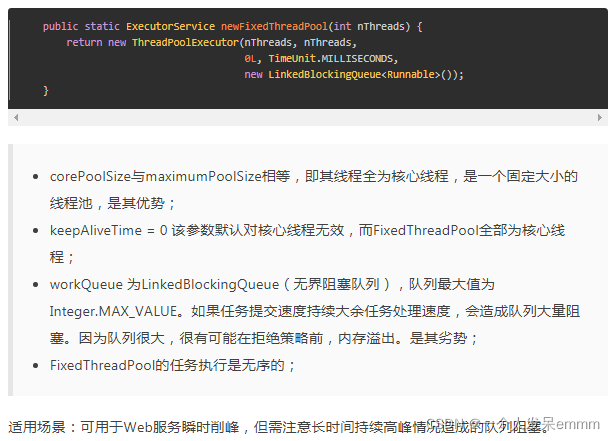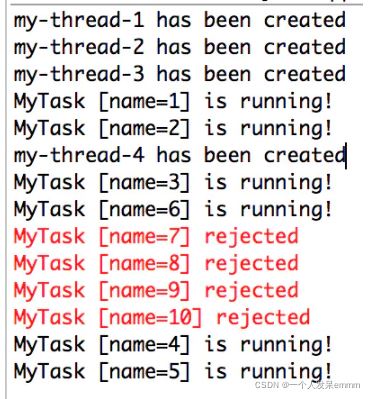java四种线程池
魔法二少 人气:0java预定义的哪四种线程池?
- newSingleThreadExexcutor:单线程数的线程池(核心线程数=最大线程数=1)
- newFixedThreadPool:固定线程数的线程池(核心线程数=最大线程数=自定义)
- newCacheThreadPool:可缓存的线程池(核心线程数=0,最大线程数=Integer.MAX_VALUE)
- newScheduledThreadPool:支持定时或周期任务的线程池(核心线程数=自定义,最大线程数=Integer.MAX_VALUE)
四种线程池有什么区别?
上面四种线程池类都继承ThreadPoolExecutor,在创建时都是直接返回new ThreadPoolExecutor(参数),它们的区别是定义的ThreadPoolExecutor(参数)中参数不同,而ThreadPoolExecutor又继承ExecutorService接口类
- newFixedThreadPool
定义:
xecutorService executorService=Executors.newFixedThreadPool(2);

缺点:使用了LinkBlockQueue的链表型阻塞队列,当任务的堆积速度大于处理速度时,容易堆积任务而导致OOM内存溢出
- newSingleThreadExecutor
定义:ExecutorService executorService =Executors.newSingleThreadExecutor();

上面代码神似new FixedThreadPoop(1),但又有区别,因为外面多了一层FinalizableDelegatedExecutorService,其作用:

可知,fixedExecutorService的本质是ThreadPoolExecutor,所以fixedExecutorService可以强转成ThreadPoolExecutor,但singleExecutorService与ThreadPoolExecutor无任何关系,所以强转失败,故newSingleThreadExecutor()被创建后,无法再修改其线程池参数,真正地做到single单个线程。
缺点:使用了LinkBlockQueue的链表型阻塞队列,当任务的堆积速度大于处理速度时,容易堆积任务而导致OOM内存溢出
newCacheThreadPool
定义:ExecutorService executorService=Executors.newCacheThreadPool();

缺点:SynchronousQueue是BlockingQueue的一种实现,它也是一个队列,因为最大线程数为Integer.MAX_VALUE,所有当线程过多时容易OOM内存溢出
ScheduledThreadPool
定义:ExecutorService executorService=Executors.newScheduledThreadPool(2);
源码:
public static ScheduledExecutorService newScheduledThreadPool(int corePoolSize) {
//ScheduledThreadPoolExecutor继承ThreadPoolExecutor
return new ScheduledThreadPoolExecutor(corePoolSize);
}
public ScheduledThreadPoolExecutor(int corePoolSize) {
//ScheduledThreadPoolExecutor继承ThreadPoolExecutor,故super()会调用ThreadPoolExecutor的构造函数初始化并返回一个ThreadPoolExecutor,而ThreadPoolExecutor使实现ExecutorService接口的
//最终ScheduledThreadPoolExecutor也和上面几种线程池一样返回的是ExecutorService接口的实现类ThreadPoolExecutor
super(corePoolSize, Integer.MAX_VALUE, 0, NANOSECONDS,
new DelayedWorkQueue());
}
线程池有哪几个重要参数?
ThreadPoolExecutor构造方法如下:


- keepAliveTime是指当前线程数位于 [核心线程数,最大线程数] 之间的这些非核心线程等待多久空闲时间而没有活干时,就退出线程池;
- 等待丢列的大小与最大线程数是没有任何关系的,线程创建优先级=核心线程 > 阻塞队列 > 扩容的线程(当前核心线程数小于最大线程数时才能扩容线程)
- 假如核心线程数5,等待队列长度为3,最大线程数10:当线程数不断在增加时,先创建5个核心线程,核心线程数满了再把线程丢进等待丢列,等待队列满了(3个线程),此时会比较最大线程数(只有等待丢列满了最大线程数才能出场),还可以继续创建2个线程(5+3+2),若线程数超过了最大线程数,则执行拒绝策略;
- 假如核心线程数5,等待队列长度为3,最大线程数7:当线程数不断在增加时,先创建5个核心线程,核心线程数满了再把线程丢进等待丢列,当等待队列中有2个线程时达到了最大线程数(5+2=7),但是等待丢列还没满所以不用管最大线程数,直到等待丢列满了(3个阻塞线程),此时会比较最大线程数(只有等待丢列满了最大线程数才能出场),此时核心+等待丢列=5+3=8>7=最大线程数,即已经达到最大线程数了,则执行拒绝策略;
- 如果把等待丢列设置为LinkedBlockingQueue无界丢列,这个丢列是无限大的,就永远不会走到判断最大线程数那一步了
如何自定义线程池
可以使用有界队列,自定义线程创建工厂ThreadFactory和拒绝策略handler来自定义线程池
public class ThreadTest {
public static void main(String[] args) throws InterruptedException, IOException {
int corePoolSize = 2;
int maximumPoolSize = 4;
long keepAliveTime = 10;
TimeUnit unit = TimeUnit.SECONDS;
BlockingQueue<Runnable> workQueue = new ArrayBlockingQueue<>(2);
ThreadFactory threadFactory = new NameTreadFactory();
RejectedExecutionHandler handler = new MyIgnorePolicy();
ThreadPoolExecutor executor = new ThreadPoolExecutor(corePoolSize, maximumPoolSize, keepAliveTime, unit,
workQueue, threadFactory, handler);
executor.prestartAllCoreThreads(); // 预启动所有核心线程
for (int i = 1; i <= 10; i++) {
MyTask task = new MyTask(String.valueOf(i));
executor.execute(task);
}
System.in.read(); //阻塞主线程
}
static class NameTreadFactory implements ThreadFactory {
private final AtomicInteger mThreadNum = new AtomicInteger(1);
@Override
public Thread newThread(Runnable r) {
Thread t = new Thread(r, "my-thread-" + mThreadNum.getAndIncrement());
System.out.println(t.getName() + " has been created");
return t;
}
}
public static class MyIgnorePolicy implements RejectedExecutionHandler {
@Override
public void rejectedExecution(Runnable r, ThreadPoolExecutor e) {
doLog(r, e);
}
private void doLog(Runnable r, ThreadPoolExecutor e) {
// 可做日志记录等
System.err.println( r.toString() + " rejected");
// System.out.println("completedTaskCount: " + e.getCompletedTaskCount());
}
}
static class MyTask implements Runnable {
private String name;
public MyTask(String name) {
this.name = name;
}
@Override
public void run() {
try {
System.out.println(this.toString() + " is running!");
Thread.sleep(3000); //让任务执行慢点
} catch (InterruptedException e) {
e.printStackTrace();
}
}
public String getName() {
return name;
}
@Override
public String toString() {
return "MyTask [name=" + name + "]";
}
}
}
运行结果:

其中7-10号线程被拒绝策略拒绝了,1、2号线程执行完后,3、6号线程进入核心线程池执行,此时4、5号线程在任务队列等待执行,3、6线程执行完再通知4、5线程执行
总结
加载全部内容